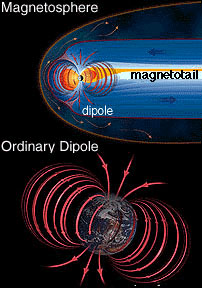Click on image for full size
Windows to the Universe original artwork.
Earth's Magnetic Field
Earth has a magnetic field. If you pretended that Earth had a gigantic bar magnet inside of it (it doesn't really, of course), you would have a pretty good idea about the approximate shape of Earth's magnetic field. Earth's magnetic field is slightly tilted with respect to the planet's spin axis; there is currently a difference of about 11° between the two. Because of this difference, the Geographic North Pole and the North Magnetic Pole are not actually in the same place; likewise for the South Poles. This means that compasses do not always point directly towards True North.
Although scientists do not understand all of the details, they know that motions of molten metals in the Earth's core generate our planet's magnetic field. Movement of molten iron and nickel generates electrical and magnetic fields that produce Earth's magnetism. The flows of these molten metals in Earth's outer core are not perfectly steady over time, so Earth's magnetic field changes over time as well. The North and South Magnetic Poles wander over time; the North Magnetic Pole moved some 1,100 km (684 miles) during the 20th century. The strength of Earth's magnetic field varies as well; it has been decreasing slightly ever since around 1850. Over the course of Earth's history the magnetic field has actually reversed itself many times, with North becoming South and vice versa!
Earth's magnetic field extends thousands of kilometers (miles) outward into space. The field forms a gigantic magnetic "bubble" in space around Earth. This magnetic bubble is called the magnetosphere. Earth's magnetosphere shields our planet from most particle radiation that flows our way from the Sun and other radiation sources in space. The magnetosphere is not actually a sphere; it is shaped more like a teardrop, with a long "tail" extending away from the Sun.
Although Earth's magnetic field is roughly a dipole (like the field of a bar magnet) to a first approximation, it has a much more complex shape than a simple dipole field. The uneven flows and distributions of the molten metals that generate Earth's field cause the field to be quite "lumpy". The pressure of the solar wind, the stream of charged particles flowing outward from the Sun, also distorts the shape of the magnetic field surrounding Earth.
The names given to the Magnetic North and South Poles are potentially quite confusing. Recall that opposite poles of magnets attract, while like poles repel each other. If you take two bar magnets, and place their North Poles near each other, they will push themselves apart; likewise for two South Poles. If you place a North Pole near a South Pole, they will pull themselves together. The needle of a compass is a small bar magnet, with a North and a South Pole. The North Pole of the compass needle points North (roughly). But the North Pole of a magnet is attracted to a South Pole of another magnet. So Earth's North Magnetic Pole is actually a South Pole of a magnet!
Several other planets, and even a few moons, in our Solar System also have magnetic fields. Our Moon has a very weak magnetic field, as does the planet Mars. Mercury's field is a bit stronger. The giant planets Jupiter and Saturn have extremely powerful fields. Uranus and Neptune also have fairly strong fields. We don't know about Pluto yet, but it is unlikely to have a strong field if it has one at all. Venus does not have a magnetic field, probably because it rotates so slowly. Jupiter's moon Ganymede also has a magnetic field, and we have tentative hints that some other moons may have weak fields as well.















